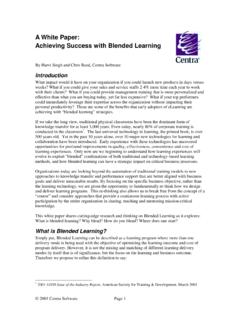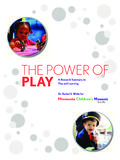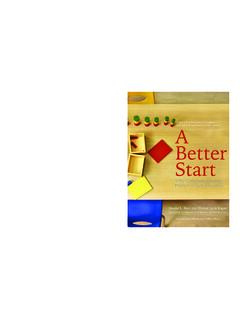Transcription of LEARNING TO READ THE TIBETAN SCRIPT
1 PRESERVING TIBETAN50 MANDALAJune/July 2006 In the last column I discussed the coming of the Dharmato Tibet with special emphasis on the role the TIBETAN languageplayed in that process. In this column I would like to begin toteach howto actually read the TIBETAN SCRIPT . If an Englishspeaker who speaks or reads no other language wishes to learnFrench, Italian, or German, he or she will know how to readthe SCRIPT and use the dictionary since all of these languageshave alphabets based on the one used by the Romans, and theyall have the same dictionary word order. But when learningTibetan, we first need to learn to read a very foreign-lookingscript. At first glance, this might seem quite difficult. It is not,however, as impossible as it might seem because there is a verylogical system of organization to the TIBETAN that is unlike any-thing found in English or the other European languages. TIBETAN is written in a variety of different scripts.
2 Theone most commonly seen in the traditional Buddhist texts iscall u-chen(pronounced oo-chen ). It is also the SCRIPT usedin all Western Dharma center editions of practice texts whenthe original TIBETAN is is also the SCRIPT usedin all the TIBETAN -English dictionaries. So although it is notthe first SCRIPT learned byTibetan school children (they mustinitially learn one that is more difficult), u-chenis the onemost practical for Western Buddhist students to learn first. By the way, what is often called the TIBETAN alphabet ismore properly termed a syllabary, for unlike the Englishalphabet, which is a list of letters, what we have in theTibetan is rather a list of thirty syllables. The New ShorterOxford English Dictionarydefines a syllabary as .. a list orsystem of characters representing syllables and (in somelanguages or stages of writing) serving the purpose of analphabet. This is what we have in is traditionally taught with reference to a chartor matrix containing eight rows and four columns of char-acters, each of which is a consonant.
3 The last row only hastwo characters. So, we have a total of thirty are profound and far-reaching reasons why these thirtysyllables the thirty consonants are arranged in this will discuss this further in future columns as our explo-ration of TIBETAN I would now like to present is a simplified approachto reading the TIBETAN SCRIPT . For, once one knows how to readthe SCRIPT , the original hurdle to LEARNING TIBETAN , which in thebeginning can seem so formidable, is left behind. One canthen go on to acquire a basic Dharma vocabulary in TIBETAN ,which is so useful in becoming a better-educated Dharmapractitioner. Later, one can begin to read practice texts inTibetan. Students always find this an illuminating experience,even though it is necessarily a slow process in the beginning. The first step then is to learn to read the thirty consonantsof the syllabary. TIBETAN is read left to right and top to bottom just like English.
4 Looking at the chart of the syllabary, wenote that each of the consonants has an sound repre-sented by this Ais pronounced Ah. This sound was taughtby the Buddha in the Prajnaparamita Sutras as .. the perfec-tion of wisdom in one letter. Whenever TIBETAN is transcribed into English (that is,written with English or Roman letters), the letter Arepre-sents the sound Ah. When we transcribe TIBETAN intoLEARNING TO READTHE TIBETAN SCRIPTBy David Curtis June/July 2006 MANDALA51 English for the purpose of approxi-mating the sound of TIBETAN , we usewhat are called phonetics (from theGreek word phonomeaning sound ).So the English letters beneath theTibetan in the matrix in the accompa-nying chart are the phonetics. Butwhen we transcribe TIBETAN intoEnglish to indicate the spelling in theoriginal TIBETAN , we have what iscalled the transliteration (from theLatin transmeaning across and literameaning letters bringing the let-ters across from one language to anoth-er).
5 In some languages the phoneticsand the transliteration are equivalent,but this is not the case in TIBETAN , so itis good to remember the distinctionbetween phonetics and transliterationwhen talking about again at the chart, we seethat below the first three syllables of thefifth row and over the last letter in thatrow in the syllabary there is a dividingline. This divides the chart into twosections and is extremely we will discuss the nineteen con-sonants above this dividing the Dividing Line. In thetop portion of the syllabary we havefive rows and four columns. There is aseries of rules that govern the pronun-ciation of each of these that for each of thesesounds theAis to be pronounced like Ah. The Rows. In the first row we findKA, K A, GA, and NGA. All of thesesyllables are pronounced in the back ofthe throat. In the second row all of thesyllables CHA, CH A, JA, and NYA are pronounced at the roof of the mouth.
6 In the third row, allthe syllables TA, T A, DA, and NA are pronounced withthe tip of the tongue at the back of the teeth. All the syllablesin the fourth row PA, P A, BA, and MA are made at thelips. And lastly, the first three consonants of the fifth row TSA, TS A, and DZA are pronounced at the palate Columns. Now let us look at the columns above thedividing line. All the syllables in the first column of the firstfive rows KA, CHA, TA, PA, and TSA are very short with a high tone. (Don tworry, there are only two tones inTibetan: One is high in the same manneras when we are happy to remembersomething and say Oh! ; the other is alow tone as when we put our feet up atthe end of a long day and say Ah ). Allthe second column sounds K A,CH A, T A, P A, and TS A are like thefirst sound in each row, but with theaddition of aspiration or the third column consonants GA,JA, DA, BAand DZA are long andlow.
7 And all the fourth column sounds NGA, NYA, NA, and MA are longand low with a nasal Tip:One techniquewhen LEARNING a new body of materialis to absorb it gradually in smallamounts. Thoroughly master one stepat a time. Begin by LEARNING small bitsthoroughly. It has been said that rep-etition is the mother of mastery. Forpurposes of memorization, it is farbetter to repeat a short section manytimes than to repeat something muchlonger only once or twice. In working with the thirty conso-nants it is good, therefore, to work withone row at a time. Work left to rightand top to bottom. Using a mala (theBuddhist prayer beads) and repeatingeach row twenty-one times whileconcentrating on the form of the con-sonants can be an effective way to learnthe thirty consonants. We can learn alot by short study sessions throughoutthe the Dividing Line. Now forthe syllables below the dividing line:The first syllable in the fifth row is WA,and it is pronouncedlike wa in watch.
8 The syllables in the sixth row ZHA, ZA, A, YA all have a low tone. ZHAis pronounced like the Zsa in Zsa Zsa first two syllables in the seventh row RAand LA are pronounced just like in English. The last two syllablesin the seventh row the SHAand the SA are pronouncedwith a high example of u-chen SCRIPT , written by KaluRinpoche in his later years. This says KA DAK RIKPA, meaning primordially pure awareness. The two letters of the eight row HAand A areeach pronounced with a high those are the thirty consonants and how to pro-nounce them. They make up what is commonly called the TIBETAN alphabet, but what we will call the TIBETAN syl-labary. As already pointed out, each of them is a syllableunto itself. But what is more, many of them are alsowords. So now we can talk just a bit about the very first of the consonants, and because it isthe first, it can mean primordial, the earliest, the first in aseries.
9 This is similar to the way we use the English aorthe Greek letter alpha. NGA, the hardest consonant forEnglish speakers to pronounce, is, ironically, the Tibetanword for I or me. We will talk more about vocabularyin subsequent columns. yDavid Curtis is founder the TibetanLanguage Institute, a non-profit501 (c) (3) in 1996. He now pres-ents introductory classes and readingseminars on TIBETAN 2006 PRESERVING TIBETANSANG GYAYBUDDHALast time we presented the word jang chub(pro-nounced jang choob ), the word that is commonlytranslated as enlightenment. We saw that its two sylla-bles mean purified and perfected respectively. Ournew word for this lesson is the TIBETAN word for Buddha,sang gyay(pronounced song gyay ). When we look at theetymology for this word, we see that it is closely related tothe word for enlightenment. Sang means awakened (asfrom the sleep of ignorance) or purified (as in purifiedof all obscurations).
10 Gyaymeans expanded, blossomed,fully developed. So, the two syllables combine to mean one such as Shakyamuni Buddha, who has purified allthe obscurations (sang) and who has developed fully allthe qualities of enlightenment (gyay). TIBETANLANGUAGE INSTITUTEA non-profit educational :406-961-5131 Email: Box 2037, Hamilton, MT 59840 Introduction to the TIBETAN Language, Beginners' PackagePre-primer, Level I manual, audio-CD or cassette, easy-to-useFlashcards, TIBETAN -English Dictionary. Price $ !DVD of Level I CourseDavid Curtis s highly successful course on LEARNING to read TIBETAN ,condensed into a three-hour presentation, in a studio recorded 2 DVD set. Price $ Vocabulary Flashcards and Dharma inspiring sets to help acquire essential vocabulary. Price $ eaOther Packages: Level II Package, Reader Packages I and IIAlso Available: Grammars, Translation Workbooks, Cassette tapes, DVD s,CD s, Print and Electronic Dictionaries, and an extensive collection of Dharmabooks at our website bookstore.






